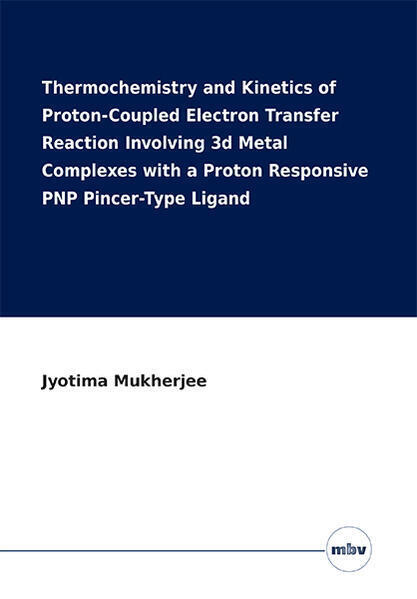Bitte haben Sie einen Moment Geduld, wir legen Ihr Produkt in den Warenkorb.
| ISBN | 9783967292800 |
|---|---|
| Sprache | Englisch |
| Erscheinungsdatum | 01.06.2025 |
| Genre | Chemie/Anorganische Chemie |
| Verlag | Mensch & Buch |
| Lieferzeit | Lieferung in 7-14 Werktagen |
- ✔ kostenlose Lieferung innerhalb Österreichs ab € 35,–
- ✔ über 1,5 Mio. Bücher, DVDs & CDs im Angebot
- ✔ alle FALTER-Produkte und Abos, nur hier!
- ✔ hohe Sicherheit durch SSL-Verschlüsselung (RSA 4096 bit)
- ✔ keine Weitergabe personenbezogener Daten an Dritte
- ✔ als 100% österreichisches Unternehmen liefern wir innerhalb Österreichs mit der Österreichischen Post
The synthesis of a PNP-type ligand featuring an acidic pyridin-4-ol unit has been successfully reproduced following a previously reported protocol. The ligand was characterized using common spectroscopic techniques. The corresponding deprotonated and protonated Nickel and Cobalt complexes were isolated and characterized properly.
X-ray crystallography of 3 and 3H+, presented a square planar geometry around the nickel center. The optimized structures at the B3LYPD3(BJ)/def2-TZVP level of theory closely matched the experimentally obtained bond parameters.
Elemental analysis of complex 6H2+ indicated the presence of two acetonitrile molecules, which was further confirmed by single-Crystal XRD, which showed a distorted penta-coordinated, square pyramidal environment around the Co(II) ion in 7+. IR spectroscopy and elemental analysis indicated loss of one solvent molecule and a change in coordination upon deprotonation of 6H2+ forming 6+.
With the estimated pKa values and redox potentials, BDFEs of the two complexes 3H and 6H+, were determined ~ 47 and 52 kcal mol−1, respectively. Theoretically, computed values were consistent with the experimentally determined BDFEs (Scheme 4.1). Consequently, the synthesis of Ni and Co complexes with low BDFEs was successfully achieved.
Given that H2 evolution is thermodynamically favorable from complexes with BDFEs lower than 52 kcal mol−1, the reactivity of 3H and 6H+ was further investigated. Upon (electro)chemical reduction, UV/Vis spectroscopy revealed the formation of new species in both cases, identified as 3 and 6+, respectively, by comparison with pure samples. This suggests the loss of an H atom from 3H and 6H+ over time, with isosbestic points in the UV/Vis spectra indicating a single kinetic step reaction. The conversion of 3H to 3 occurred within 10 minutes at room temperature, while the conversion of 6H+ to 6+ was much slower, taking approximately 3 hours at room temperature.
Further investigations showed that, in the case of the 3H, the H atom was rapidly transferred to suitable substrates like TEMPO• and MeCN, with H2 evolution observed only in inert solvents like THF (Scheme 4.2, left). Conversely, 6H+ was less reactive than 3H, with H2 evolution detected in MeCN (Scheme 4.2, right). A detailed kinetic study of H2 evolution from in-situ prepared 6H+ using UV/Vis spectroscopy indicated that the rate of 6H+ consumption was four times slower compared to the previously reported Re complex by Fujita and coworkers.
Kinetic investigations of H-atom transfer from 6H+ to TEMPO• at ‒35 °C using stopped-flow UV/Vis spectroscopy led to a second-order reaction rate constant (k2) of about 104 s–1 M–1, corresponding to an activation barrier of approximately 12 kcal mol–1 according to transition state theory suggesting a concerted PCET transfer reaction rather than a stepwise PT/ET or ET/PT transfer. Finally, several attempts were also made to use 6H+ as a mediator for the electrohydrogenation of ketones and alkenes.
The presence of a stronger electron-donating amide-type ligand allows the formation of the reduced complexes 3H and 6H+ with moderately strong reducing agents like CoCp2, making them promising candidates for electrochemically driven PCET reactions. Future investigations could explore the possibility of catalytic electrohydrogenation using 3H as a low BDFE mediator for suitable unsaturated substrates (e.g., C=O, C=C) in inert solvents like THF, in the presence of suitable mild acids. Additionally, since 6H+ has shown the potential to mediate the electrochemical hydrogenation of sterically hindered ketones, expanding the substrate scope is essential to establish this finding. Exploring different mild acids, such as trifluoroethanol (TFE), could also enhance the substrate range in this regard.
| ISBN | 9783967292800 |
|---|---|
| Sprache | Englisch |
| Erscheinungsdatum | 01.06.2025 |
| Genre | Chemie/Anorganische Chemie |
| Verlag | Mensch & Buch |
| Lieferzeit | Lieferung in 7-14 Werktagen |
- ✔ kostenlose Lieferung innerhalb Österreichs ab € 35,–
- ✔ über 1,5 Mio. Bücher, DVDs & CDs im Angebot
- ✔ alle FALTER-Produkte und Abos, nur hier!
- ✔ hohe Sicherheit durch SSL-Verschlüsselung (RSA 4096 bit)
- ✔ keine Weitergabe personenbezogener Daten an Dritte
- ✔ als 100% österreichisches Unternehmen liefern wir innerhalb Österreichs mit der Österreichischen Post
Wie gefällt Ihnen unser Shop?



